Apple's 2010 MacBook Air (11 & 13 inch) Thoroughly Reviewed
by Anand Lal Shimpi on October 26, 2010 10:08 PM EST- Posted in
- Mac
- Apple
- MacBook Air
- Laptops
The SSD: Not Half Bad
Apple advertises the new MacBook Air as being instant on as a result of the internal SSD. That’s mostly untrue. From a completely powered off state the MacBook Air still takes time to boot. That time is significantly reduced compared to the old MacBook Air and any other Mac with a conventional hard drive. It’s even a shorter boot than my MacBook Pro with a SandForce SF-1200 based SSD in it:
| System Performance Comparison | ||||||
| Boot | Shut Down | Sleep | Awake | |||
| 11-inch MacBook Air | 15.5 seconds | 2.2 seconds | 1.0 second | 1.63 seconds | ||
| 13-inch MacBook Air | 14.4 seconds | 1.9 seconds | 1.0 second | 1.56 seconds | ||
| 13-inch MacBook Air (Late 2008) | 34.4 seconds | 2.9 seconds | 1.6 seconds | 4.19 seconds | ||
| 15-inch MacBook Pro (SF-1200 SSD) | 19.1 seconds | 1.8 seconds | 1.5 seconds | 2.3 seconds | ||
| 15-inch MacBook Pro (Mid 2009, HDD) | 34.2 seconds | 2.8 seconds | 1.8 seconds | 2.1 seconds | ||
You'll notice that even the SF-1200 SSD in my 15-inch MacBook Pro takes longer to boot than these new Airs. Apple does customize the firmware on its SSDs. I’d be willing to bet the SSD in the MacBook Air has tight integration with OS X to guarantee quicker than normal boot times.
Clearly the new Air isn't instant on from a boot standpoint, but it's pretty much there from a recover-from-sleep standpoint. The new Airs both go to sleep and wake up from sleep quicker than any of the other Macs, including my upgraded 15-inch Core i7 MacBook Pro. Again, nothing can trump Apple's tight integration between hardware and software.
Apple likes to work with two different controller manufacturers for SSDs: Samsung and Toshiba. iFixit already confirmed Toshiba is in the new MacBook Air with its teardown:
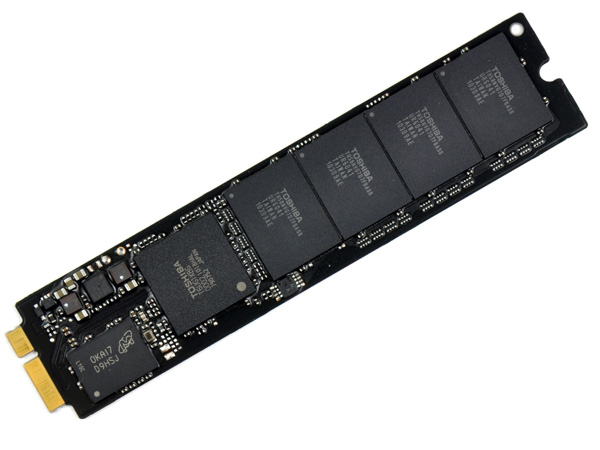
The 11-inch MacBook Air SSD, courtesy of iFixit
The SSD isn’t in an industry standard form factor, although the connector appears to be either micro or mini SATA. Presumably 3rd party SSD manufacturers (ahem, SandForce partners I’m looking at you) could produce drop in replacements for the MacBook Air SSD.
There’s nothing particularly innovative about the form factor of the SSD, other than Apple did away with the unnecessary space a 2.5” SSD would require. Just as SSDs will break the traditional SATA interface barriers, we’ll see the same happen to form factors as well.
The part number on the Toshiba controller may look familiar to some of you. It’s the same controller that’s in Kingston’s SSDNow V+ Series and the SSDNow V Series Boot Drive. I reviewed the latter not too long ago and found that it was a good drive for the money, and here’s the kicker: the SSDNow V Series Boot Drive was amazingly resilient when written to without TRIM support. Its performance hardly dropped as a result of normal desktop use. This is very important because although OS X 10.6.4 has a field for reporting TRIM support on an SSD, the instruction isn’t actually supported by the OS. Even the new MacBook Airs don’t ship with a version of OS X with TRIM support.
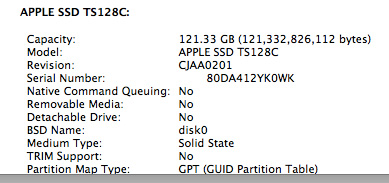
The SSD only has four NAND devices on it. Typically that would mean some very low transfer speeds, particularly on writes. But each one of those four devices has at least 16GB of NAND, spread across multiple planes and die. With the right firmware, you should be able to extract a good deal of parallelism from this architecture. Apple and Toshiba apparently do just that.

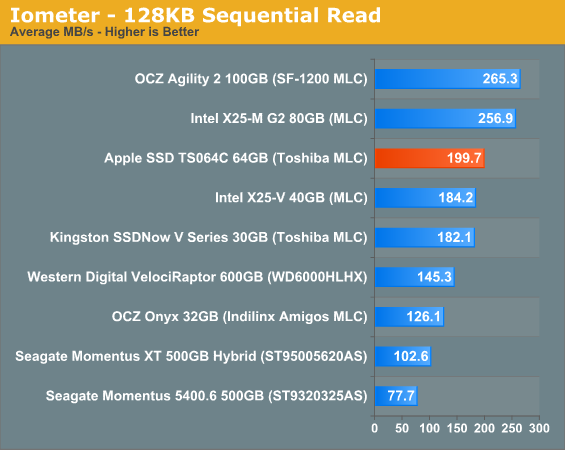
While most value SSDs top out at under 100MB/s, we get nearly 200MB/s sequential reads and writes out of the SSD in the new MacBook Air. And fortunately, Apple hasn’t only focused on sequential performance. The random read/write performance of the new MacBook Air SSD isn’t terrible:
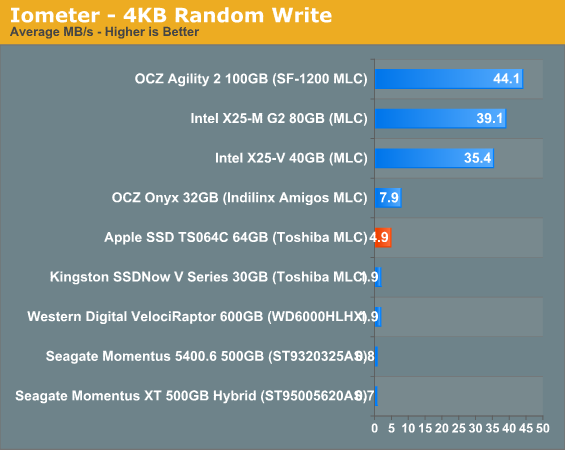
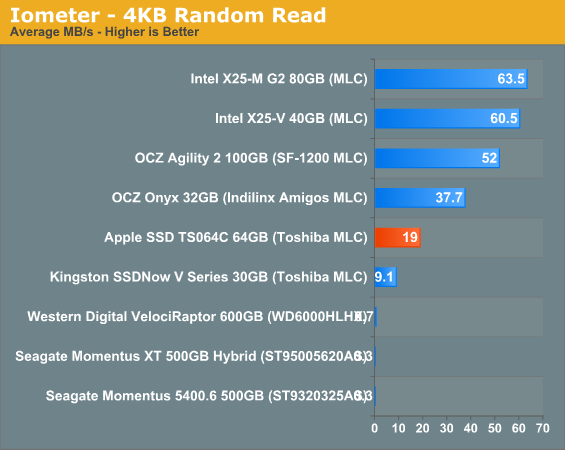
Random write performance is of course the weak point, but you’ll notice that it’s actually higher than the Kingston drive that uses the same controller. While Apple would’ve been better off striking a deal with Intel or SandForce for the controller in the MacBook Air, the Toshiba controller isn’t horrible.
As I mentioned earlier, resilience is very important as OS X still doesn’t support TRIM. I filled the drive with garbage and then tortured it for 20 minutes with random writes. The resulting performance drop was noticeable, but not unbearable:
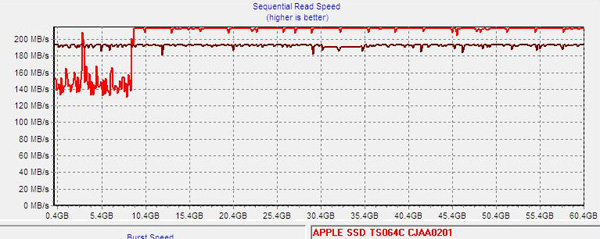
A single pass of sequential writes restores performance to normal:
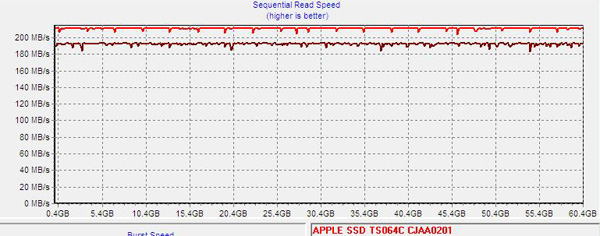
This tells us two things. First, through normal use the drive should be able to recover its performance over time (assuming you give it enough spare area). And second, if there’s any idle garbage collection in Apple’s custom firmware for the Toshiba controller it should be able to keep the drive running at peak performance even without TRIM supported in the OS. I don’t have a good way of measuring whether or not there’s GC enabled on the drive in OS X, but I suspect Apple is (at least it appears to be doing so on the Mac Pro’s SSDs).
Overall I’m pleased with Apple’s SSD selection. It could’ve been a lot better but it could’ve been a lot worse. The MacBook Airs in their default configuration have better IO performance than any other standard config Mac sold on the market today, including the Mac Pro.










185 Comments
View All Comments
tipoo - Saturday, November 6, 2010 - link
I'm wondering if the larger SSD options would be faster due to more chips/parallelism? And if you could throw the SSD results from the Adamo into the test results?philipdygeus - Thursday, November 18, 2010 - link
I am looking for a new laptop and the choice is between the forthcoming 13" MBP and the new 13" MBA.The "heaviest" work I do is Photoshop CS5. I also "multitask" in the sense that I have Word, Chrome and Bridge open simultaneously, though I would only use one at the time.
What battery life can I expect from the 13" MBA when using CS5?
Thanks for any real-world insight!
Philip
info [at] philipus.com
bailwill - Tuesday, December 14, 2010 - link
Hi when you reviewed the 2008 Air you helpfully stated that trying to watch 2 dvd's back to back failed after about 3 3/4 hours. Sadly I could not find this test for the 2010 air - and as I fly a lot it would be useful to know how long the battery will last in DVD watching mode.Thanks
Martyn
redslap - Tuesday, January 4, 2011 - link
I have to say that I have never been as satisfied with a computer purchase as when I bought my Acer Timeline with SSD back in August 2009. Granted, I bought it on a trip to the states so I really got a sweet deal for 800 dollars instead of euros. However, the netbook has performed well over expectation. I have been using it everyday. The Macbook Pro 2008 Im currently writing on had a hard drive failure in early June and I only got around fixing it yesterday (with SSD ;-), mainly because I was doing fine with my timeline. It has no where near the processing power but I used it a ton for surfing the web, taking notes in class and the SSD must have really made a difference because it felt as snappy as my macbook pro in these instances. Furthermore I had no problem using Traktor and Virtual DJ as well as sound recording and editing with Adobe Audition. Coupled with a good screen, half the weigh of my macbook, the ability to fire up a strategy game like civ 4 or medieval 2 in class or on the road has been awesome and with a battery life of 7 hours; it will surely be missed now that the screen broke during my holiday travel. Alas, I will not give up on my Timeline...NYCPHOTO - Sunday, February 20, 2011 - link
I own a MacBook Air 13" and the battery life just wasn't good enough for me. I got only a few hours per charge and that is if I was lucky. My eventual solution was to get an external laptop battery from Novuscell Batteries. So far, no regrets because I'm now getting an extra 12+ hours of battery runtime per charge on my Air.